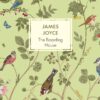Virginia Woolf – Kew Gardens
Design: Hanna Hallin
Seitenzahl: 24
Then the breeze stirred rather more briskly overhead and the colour was flashed into the air above, into the eyes of the men and women who walk in Kew Gardens in July. The figures of these men and women straggled past the flowerbed with a curiously irregular movement not unlike that of the white and blue butterflies who crossed the turf in zig-zag flights from bed to bed.
Kew Gardens encapsulates the flair of modernism and Woolf’s pioneering literary style. Set in the titular botanical garden in south-west London on a warm summer day, the story is a collection of glimpses into the lives of four groups of visitors. Told in intricate and lavish detail by an unnamed narrator, the story has no unifying narrative. Rather, it follows the visitors as they meander past a lustrous bed of flowers – giving a fleeting snippet of their lives: their memories, associations and reflections, all spurred by the spawling greenery.
A leading figure in modernist literature, Virginia Woolf (1882–1941) is considered one of the most important writers of the 20th century. More than eighty years after her death, her work continues to remain relevant in the modern world. Woolf’s body of work includes novels, essays, and short stories. Among her most celebrated novels are Mrs. Dalloway (1925), To the Lighthouse (1927), and Orlando (1928), in addition to her feminist essay A Room of One’s Own (1929). Virginia and her husband, Leonard Woolf, co-founded the publishing house Hogarth Press and were both members of the renowned Bloomsbury Group. Although Woolf experimented with various forms of prose, only one collection of short stories was published in her lifetime. Kew Gardens was part of the short-story collection A Haunted House and Other Stories, published posthumously in 1944.




